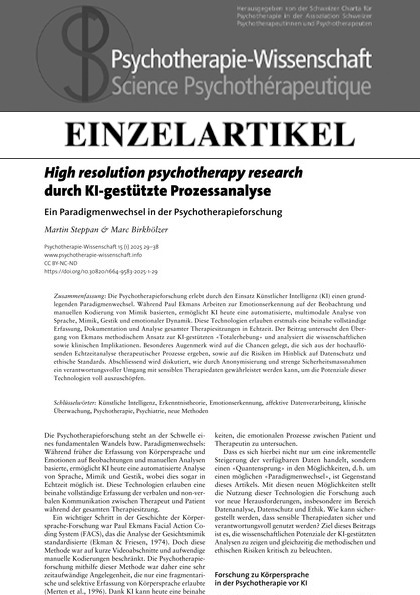High resolution psychotherapy research through AI-supported process analysis
A paradigm shift in psychotherapy research
DOI:
https://doi.org/10.30820/1664-9583-2025-1-29Keywords:
artificial intelligence, epistemology, emotion recognition, affective computing, clinical supervision, psychotherapy, psychiatry, new methodsAbstract
Psychotherapy research is undergoing a fundamental paradigm shift driven by the use of artificial intelligence (AI). While Paul Ekman’s work on emotion recognition was based on the observation and manual coding of facial expressions, AI now enables automated, multimodal analysis of speech, facial expressions, gestures, and emotional dynamics. These technologies allow for the near-complete recording, documentation, and analysis of entire therapy sessions in real time for the first time. This paper examines the transition from Ekman’s methodological approach to AI-supported «total data collection» and analyzes the scientific and clinical implications. Special attention is given to the opportunities arising from high-resolution real-time analysis of therapeutic processes, as well as the risks concerning data privacy and ethical standards. Finally, the discussion addresses how anonymization and strict security measures can ensure the responsible use of sensitive therapy data, unlocking the full potential of these technologies.
Downloads
How to Cite
Steppan, M., & Birkhölzer, M. (2025). High resolution psychotherapy research through AI-supported process analysis: A paradigm shift in psychotherapy research. Psychotherapie-Wissenschaft, 15(1), 29–38. https://doi.org/10.30820/1664-9583-2025-1-29
Issue
Section
Special Issue
License

This work is licensed under a Creative Commons Attribution-NonCommercial-NoDerivatives 3.0 Unported License.
This journal provides open access to its content in accordance with the basic premise that the free public availability of research benefits the exchange of knowledge throughout the world.
Authors wishing to publish in this journal agree to the following:
- The author/s retain/s the copyrights and consent/s to initial publication of the work in the journal under a Creative Commons Attribution licence, which allows third parties to use the work by citing the name/s of the author/s and this journal as initial publisher (in accordance with the Creative Commons Attribution-NonCommercial-NoDerivs 3.0 DE-Licence).
- The author/s can enter into additional contracts for the non-exclusive distribution (e.g. publish in a collection or book) of the version published in the journal, if the journal is cited as initial publisher.


